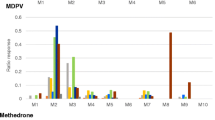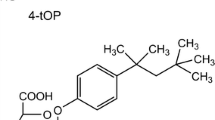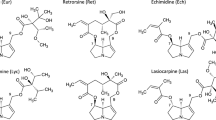Abstract
Kinetics of the metabolism of 1,2-epoxybutene-3 (butadiene monoxide) were investigated in liver fractions of mouse, rat, and man. In these species similar enzyme characteristics were found. In microsomes, no NADPH-dependent metabolism of butadiene monoxide was detectable. Epoxide hydrolase activity was found only in microsomes. The Vmax [nmol butadiene monoxide/(mg protein x min)] was 19 in mouse, 17 in rat, and 14 in man and the apparent Km (mmol butadiene monoxide/l incubate) was 1.5 in mouse, 0.7 in rat, and 0.5 in man. Glutathione S-transferase activity was found in cytosol only, revealing first order kinetics in the measured range. The ratio Vmax/Km [(nmol butadiene monoxide x l)/(mg protein × min × mmol of butadiene monoxide)] was 15 in mouse, 11 in rat, and 8 in man. The data obtained were used to extrapolate on the total rate of butadiene monoxide metabolism for each species in vivo: it was calculated to be 1.3 times higher in mice and 2.3 times lower in man compared to rats, when corrected for body weight.
Similar content being viewed by others
References
Alberts B, Bray D, Lewis J, Raff M, Roberts K, Watson JD (1983) Molecular biology of the cell. Garland Academic Press, New York, pp 319–384
Andersson C, Söderström M, Mannervik B (1988) Activation and inhibition of microsomal glutathione transferase from mouse liver. Biochem J 249: 819–823
Bolt HM, Filser JG, Oesch F, Guenthner TM, Friedberg T, Bolt M (1981) Metabolisierung von Vinylchlorid: Unterschiede zwischen Mensch und Versuchstier und ihre toxikologische Bedeutung. Bericht über die 21. Jahrestagung der deutschen Gesellschaft für Arbeitsmedizin e. V.: Epidemiologische Ansätze im Bereich der Arbeitsmedizin-Arbeitsmedizinisches Kolloquium, pp 507–509
Bolt HM, Schmiedel G, Filser JG, Rolzhäuser HP, Lieser K, Wistuba D, Schurig V (1983) Biological activation of 1,3-butadiene to vinyl-oxirane by rat liver microsomes and expiration of the reactive metabolite by exposed rats. J Cancer Res Clin Oncol 106: 112–116
Bond JA, Dahl AR, Henderson RF, Dutcher JS, Mauderly JL, Birnbaum LS (1986) Species differences in the disposition of inhaled butadiene. Toxicol Appl Pharmacol 84: 617–627
Bond JA, Martin OS, Birnbaum LS, Dahl AL, Melnick RL, Henderson RK (1988) Metabolism of 1,3-butadiene by lung and liver microsomes of rats and mice repeatedly exposed by inhalation to 1,3-butadiene. Toxicol Lett 42: 143–151
Boxenbaum H (1980) Interspecies variation in liver weight, hepatic blood flow, and antipyrine intrinsic clearance: extrapolation of data to benzodiazepines and phenytoin. J Pharmacokinet Biopharm 8: 165–176
Cantoni L, Salmona L, Facchinetti T, Pantarotto C, Belvedere G (1978) Hepatic and extrahepatic formation and hydration of styrene oxide in vitro in animals of different species and sex. Toxicol Lett 2: 179–186
Carpenter CP, Shaffer CB, Weil CS, Smyth HF (1944) Studies on the inhalation of 1,3-butadiene; with a comparison of its narcotic effect with benzol, toluol, and styrene, and a note on the elimination of styrene by the human. J Indust Hyg Toxicol 26: 69–78
Citti L, Gervasi PG, Turdu G, Bellucci G, Bianchini R (1984) The reaction of 3,4-epoxy-l-butene with deoxyguanosine and DNA in vitro: synthesis and characterization of the main adducts. Carcinogenesis 5: 47–52
Del Monte M, Citti L, Gervasi PG (1985) Isoprene metabolism by liver microsomal monooxygenasis. Xenobiotica 15: 591–597
De Meester C (1988) Genotoxic properties of 1,3-butadiene. Mutat Res 195: 273–281
De Meester C, Poncelet F, Roberfroid M, Mercier M (1978) Mutagenicity of butadiene and butadiene monoxide. Biochem Biophys Res Commun 80: 298–305
Denlinger CL, Vesell ES (1989) Hormonal regulation of the developmental pattern of epoxide hydrolases. Biochem Pharmacol 38: 603–610
De Pierre JW, Morgenstern R (1983) Comparison of the distribution of microsomal and cytosolic glutathione S-transferase activities in different organs of the rat. Biochem Pharmacol 32: 721–723
Farooqoui MYH, Ahmed AE (1984) Circadian periodicity of tissue glutathione and its relationship with lipid perioxidation in rats. Life Sci 34: 2413–2418
Filser JG, Bolt HM (1984) Inhalation pharmacokinetics based on gas uptake studies VI. Comparative evaluation of ethylene oxide and butadiene monoxide as exhaled reactive metabolites of ethylene and 1,3-butadiene in rats. Arch Toxicol 55: 219–223
Friedberg T, Bentley P, Stasiecki P, Glatt HR, Raphael D, Oesch F (1979) The identification, solubilization, and characterization of microsome-associated glutathione S-transferases. J Biol Chem 254: 12028–12033
Glatt HR, Lorenz J, Fleischmann R, Remmer H, Ohnhaus EE, Kaltenbach E, Tegtmeyer F, Rüdiger H, Oesch F (1980) Individual variations of epoxide hydratase activity in human liver and lung biopsies, lymphocytes and fibroblast cultures. In: Coon MJ, Conny AH, Estabrook RW, Gelboin HV, Gillette JR, O'Brien PJ (eds) Microsomes, drug oxidations and chemical carcinogenesis II: 651–654
Glatt HR, Mertes I, Wölfel T, Oesch F (1984) Epoxide hydrolases in laboratory animals and in man. Biochem Basis Chem Carcinogen: 107–121
Hazleton Laboratories Europe (1981) 1,3-Butadiene. Inhalation teratogenicity study in the rat. Final report and addendum No. 2788-522/3, Hazleton Labs., Harrowgate HG3 1 PY, England
Hemminki K, Falck K, Vainio H (1980) Comparison of alkylation rates and mutagenicity of directly acting industrial and laboratory chemicals: epoxides, glycidyl ethers, methylating and ethylating agents, halogenated hydrocarbons, hydrazine derivatives, aldehydes, thiuram and dithiocarbamate derivatives. Arch Toxicol 46: 277–285
Huff JE, Melnick RL, Solleveld HA, Hasemann JK, Powers M and Miller RA (1985) Multiple organ carcinogenicity of 1,3-butadiene in B6C3F1 mice after 60 weeks of inhalation exposure. Science 227: 548–549
Jaeschke H, Wendel A (1985) Diurnal fluctuation and pharmacological alternation of mouse organ glutathione content. Biochem Pharmacol 34: 1029–1033
Kappus H, Bolt HM, Buchter A, Bolt W (1976) Liver microsomal uptake of 14-C vinyl chloride and transformation to protein alkylating metabolites in vitro. Toxicol Appl Pharmacol 37: 461–471
Kessler W, Denk B, Filser JG (1989) Species-specific inhalation pharmacokinetics of 2-nitropropane, methyl ethyl ketone, andn-hexane. In: Travis CC (ed) Biologically based methods for cancer risk assessment. Plenum Press, New York, pp 123–139
Kreiling R, Laib RJ, Filser JG, Bolt HM (1986) Species differences in butadiene metabolism between mice and rats evaluated by inhalation pharmacokinetics. Arch Toxicol 58: 235–238
Kreiling R, Laib RJ, Filser JG, Bolt HM (1987) Inhalation pharmacokinetics of 1,2-epoxybutene-3 reveal species differences between rats and mice sensitive to butadiene-induced carcinogenesis. Arch Toxicol 61: 7–11
Kreiling R, Laib RJ, Bolt HM (1988) Depletion of hepatic non-protein sulfhydryl content during exposure of rats and mice to butadiene. Toxicol Lett 41: 209–214
Longo V, Citti L, Gervasi PG (1985) Hepatic microsomal metabolism of isoprene in various rodents. Toxicol Lett 29: 33–37
Lorenz J, Glatt HR, Fleischmann R, Ferlinz R, Oesch F (1984) Drug metabolism in man and its relationship to that in three rodent species: monooxygenase, epoxide hydrolase, and glutathione S-transferase activities in subcellular fractions of lung and liver. Biochem Med 32: 43–56
Magdalou J, Hammock BD (1987) Metabolism of tridiphane (2-(3,5-dichlorophenyl)-2(2,2,2-trichloroethyl)oxirane) by hepatic epoxide hydrolases and glutathione S-transferases in mouse. Toxicol Appl Pharmacol 91: 439–449
Malvoisin E, Roberfroid M (1982) Hepatic microsomal metabolism of 1,3-butadiene. Xenobiotica 12: 137–144
Malvoisin E, Lhoest G, Poncelet F, Roberfroid M, Mercier M (1979) Identification and quantitation of 1,2-epoxybutene-3 as the primary metabolite of 1,3-butadiene. J Chromatogr 178: 419–425
McLellan LI, Wolf CR, Hayes JD (1989) Human microsomal glutathione S-transferase. Biochem J 258: 87–93
Mertes I, Fleischmann R, Glatt HR, Oesch F (1985) Interindividual variations in the activities of cytosolic and microsomal epoxide hydrolase in human liver. Carcinogenesis 6: 219–223
Morgenstern R, Guthenberg C, De Pierre JW (1982) Microsomal glutathione S-transferase. Eur J Biochem 128: 243–248
Oesch F (1979) Enzymes as regulators of toxic reactions by electrophilic metabolites. Arch Toxicol Suppl 2: 215–227
Oesch F, Jerina DM, Daly J (1971) A radiometric assay for hepatic epoxide hydrase activity with (7-3H) styrene oxide. Biochim Biophys Acta 227: 685–691
Oesch F, Thoenen H, Fahrlaender H (1974) Epoxide hydrolase in human liver biopsy specimens: assay and properties. Biochem Pharmacol 23: 1307–1317
Oesch F, Milbert U, Friedberg T, Wolf CR (1983) Identification of novel glutathione S-transferases in kidney and lung and the inducibility of various isozymes in liver and other organs. Extrahepat Drug Metab Chem Carcinogen: 163–170
Pacifici GM, Warholm M, Guthenberg C, Mannervik B, Rane A (1987) Detoxification of styrene oxide by human liver glutathione transferase. Hum Toxicol 6: 483–489
Pacifici GM, Franchi M, Colizzi C, Giuliani L, Rane A (1988) Glutathione S-transferase in humans: development and tissue distribution. Arch Toxicol 61: 265–269
Reitz RH, Mendrala AL, Park CN, Andersen ME, Guengerich FP (1988) Incorporation of in vitro enzyme data into the physiologically-based pharmacokinetic (PB-PK) model for methylene chloride: implications for risk assessment. Toxicol Lett 43: 97–116
Ristau C, Deutschmann S, Laib RJ, Ottenwälder H (1990) Detection of diepoxybutane-induced DNA-DNA crossliks by cesium trifluoracetate (CsTFA) density-gradient centrifugation. Arch Toxicol 64: 343–344
Ryan AJ, James MO, Ben-Zvi Zvi, Law FCP, Bend JR (1976) Hepatic and extrahepatic metabolism of 14C-styrene oxide. Environ Health Perspect 17: 135–144
Schmidt L, Loeser E (1985) Species differences in the formation of butadiene monoxide from 1.3-butadiene. Arch Toxicol 57: 222–225
Schmiedel G (1982) Mikrosomaler Metabolismus von 1,3-Butadien zu reaktiven Verbindungen. Diplomarbeit am Fachbereich Chemie der Johannes Gutenberg-Universität, Mainz
Summer KH, Eisenburg J (1985) Low content of hepatic reduced glutathione in patients with Wilson's disease. Biochem Med 34: 107–111
Tischler ME, Allen DK (1985) Comparison of thioltransferase (glutathione: disulfide oxidoreductase) from various rat tissues. Enzyme 34: 220–223
Van Duuren BL, Nelson N, Orris L, Palmes ED, Schmitt FL (1963) Carcinogenicity of epoxides, lactones and peroxy compounds. J Natl Cancer Inst 31: 41–55
Voogd CE, van der Stel JJ, Jacobs JA (1981) The mutagenic action of aliphatic epoxides. Mutat Res 89: 269–282
Wistuba D (1986) Enantioselektive Metabolisierung kleiner aliphatischer Olefine und Oxirane durch Cytochrom-P450-abhängige Monooxygenasen, Epoxid-Hydrolasen und Glutathion S-Transferasen. Dissertation in der Fakultät für Chemie und Pharmazie der Eberhard-Karls-Universität, Tübingen
Author information
Authors and Affiliations
Rights and permissions
About this article
Cite this article
Kreuzer, P.E., Kessler, W., Welter, H.F. et al. Enzyme specific kinetics of 1,2-epoxybutene-3 in microsomes and cytosol from livers of mouse, rat, and man. Arch Toxicol 65, 59–67 (1991). https://doi.org/10.1007/BF01973504
Received:
Revised:
Accepted:
Issue Date:
DOI: https://doi.org/10.1007/BF01973504




